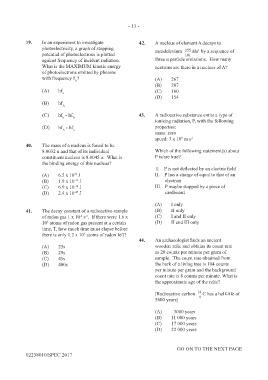Page 697 - SUBSEC October 2017_Neat
P. 697
- 13 -
39. In an experiment to investigate 42. A nucleus of element A decays to
photoelectricity, a graph of stopping mendelevium Md by a sequence of
255
potential of photoelectrons is plotted 101
against frequency of incident radiation. three α particle emissions. How many
What is the MAXIMUM kinetic energy neutrons are there in a nucleus of A?
of photoelectrons emitted by photons
with frequency f ? (A) 267
A
(B) 207
(A) hf (C) 160
o
(D) 154
(B) hf
A
(C) hf - hf 43. A radioactive substance emits a type of
o A
ionising radiation, P, with the following
(D) hf - hf properties:
A o mass: zero
speed: 3 x 10 m s -1
8
40. The mass of a nucleus is found to be
8.0032 u and that of its individual Which of the following statement(s) about
constituent nucleus is 8.0045 u. What is P is/are true?
the binding energy of this nucleus?
I. P is not deflected by an electric field
(A) 6.5 x 10 J II. P has a charge of equal to that of an
22
(B) 1.9 x 10 -13 J electron
(C) 6.9 x 10 J III. P maybe stopped by a piece of
-16
(D) 2.4 x 10 J cardboard
-47
(A) I only
41. The decay constant of a radioactive sample (B) II only
of radon gas 1 x 10 s . If there were 1.6 x (C) I and II only
-2
-1
10 atoms of radon gas present at a certain (D) II and III only
5
time, T, how much time must elapse before
there is only 1.2 x 10 atoms of radon left?
5
44. An archaeologist finds an ancient
(A) 25s wooden relic and obtains its count rate
(B) 29s as 20 counts per minute per gram of
(C) 45s sample. The count rate obtained from
(D) 400s the bark of a living tree is 104 counts
per minute per gram and the background
count rate is 8 counts per minute. What is
the approximate age of the relic?
14
[Radioactive carbon C has a half-life of
6
5600 years]
(A) 3000 years
(B) 11 000 years
(C) 17 000 years
(D) 22 000 years
GO ON TO THE NEXT PAGE
02238010/SPEC 2017

